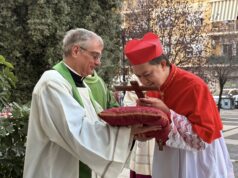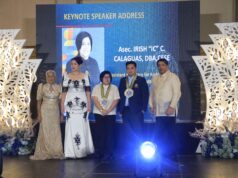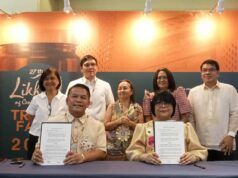Ecotourism – which involves traveling to relatively undisturbed natural areas to specifically study, admire and enjoy the scenery and its wildlife – was a highly acceptable environmental protection concept of the 1990s.
In time, the term “agritourism” came into existence. Coined from the two words – agriculture and tourism – it is a kind of a study tour among areas which have been found to adopt organic farming and sustainable agricultural production.
Perhaps one of the top agritourism destinations in the country is the farm of the Mindanao Baptist Rural Life Center (MBRLC) Foundation, Inc., a non-government organization based in Kinuskusan, Bansalan, Davao del Sur. Nestled at the rolling foothills of Mount Apo, the country’s highest peak, it is “one of its kind,” to quote the words of former agriculture secretary Sonny Dominguez.
People from all over the world – from Australia to United States, and Germany to Zimbabwe – have come to see the area. Most of its visitors, however, are from Asia: Afghanistan, Bangladesh, Bhutan, Brunei, Burma (Myanmar), Cambodia, China, East Timor, India, Indonesia, Japan, Laos, Malaysia, Mongolia, Nepal, Pakistan, Papua New Guinea, Singapore, South Korea, Sri Lanka, Taiwan, Thailand, and Vietnam.
Every year, MBRLC is host to almost 10,000 visitors. Almost daily, fervent groups arrive in batches just to see its various sustainable farming systems, which the center has developed through the years of experimentation and consultations.
“The MBRLC has been at the forefront of improving the lives of the Filipino people, both physically and spiritually,” said President Gloria Macapagal-Arroyo during the center’s 30th anniversary in 2001. “They have provided our people with the necessary guidance in order to become productive members of society.”
MBRLC has received various citations and awards from different award-giving bodies. In 1991, the regional office of the Food and Agriculture Organization bestowed the Food Day Silver Medal for “its contribution to mobilizing people’s participation in tree planting and sustainable forest resources management.” Previous to that, in 1989, then-president Corazon C. Aquino bestowed a presidential citation to the center.
Its former director, American agriculturist Harold Ray Watson, was also honored with the prestigious Ramon Magsaysay Award in 1985 for peace and international understanding “for encouraging international utilization of SALT” and other farming technologies.
So, what’s so exceptional about MBRLC? The first destination of those who come to center is its training hall, where guests and visitors are given orientation about what the center is all about and its objective, what they will see, and what they can (and cannot) do. “Jesus Christ came into this world not only to save us but also to give us an abundant life,” explained Roy C. Alimoane, the center’s current director. “What we are doing here are proofs that we can have an abundant life.”
After the brief orientation, the group walks for about five minutes for their first stopover: the internationally-known Sloping Agricultural Land Technology (SALT 1). Basically, SALT is a method of growing crops between contoured rows of nitrogen fixing trees and shrubs. The hedgerows serve as a way to control soil erosion. They are also cut every month and the cuttings are placed in the alleys to serve as fertilizer for the crops.
The group then moves to Simple Agro-Livestock Technology (SALT 2), where animals are integrated into the SALT system. “Our model farm is only one-half hectare,” says livestock supervisor Rowe Celeste. Instead of raising cattle, which requires a land area of one hectare per animal, MBRLC recommends goats. “Although a goat is small, she can produce as much as four liters of milk every day if she is purebred and is given a ration to meet all of her nutritional requirements,” he says.
The dairy goat they recommend is Anglo-Nubian. However, they are also raising Boer goats, as a source of meat. This breed originated from South Africa where the word “boer” means “farm.”
After SALT 2, the group goes to a project teeming with trees. The air is cooler and refreshing. They are now in Sustainable Agroforest Land Technology (SALT 3). “Where in the world can you find a system where trees and crops are planted together?” asks Aniano Ramos, who usually tours visitors at the farm. Actually, one hectare is devoted to forestry and another hectare to agricultural crops.
Finally, the group ends their first tour segment at the Small Agrofruit Livelihood Technology (SALT 4). See how fruit trees like rambutan, durian, lanzones, mangosteen, marang, and guava are planted together in rows. “Mindanao is touted to be the fruit basket of the country,” Alimoane says.
All these SALT systems are located in upper portion of the center’s 19-hectare farm. Zacarias B. Sarian, a recipient of the Ramon Magsaysay Award who visited the training center in 1998, commented: “It is not surprising therefore that MBRLC is a favorite destination of people from here and abroad looking for a model of upland farming.”
The second segment would be the lower part. One of the noted lowland systems is the Food Always In The Home (FAITH). Called as “refrigerator in the farm,” this 100-square-meter vegetable garden provides sufficient vegetables for a family with six members throughout the year.
The central feature of the garden is the basket composts. Their main purpose is “to directly use plant nutrients that can be derived from the rotting materials for home food production,” Alimoane says.
As a practitioner of organic farming, the center advocates vermicomposting, the process of converting biodegradable wastes from households and farms into compost (organic soil) through the action of earthworms.
The center is also raising swine, whose manure is utilized in producing biogas. Later on, the sludge is used as organic fertilizer for the fruit trees. The biogas is used in pasteurizing the milk they processed.
There are seven fish ponds found in the most lower portion of the farm. In these ponds, tilapia are raised, which are fertilizer with goat manure. In addition to commercial feeds, tilapia are also given azolla.
The center provides training to those who are interested to immerse further. “Our aim is to promote projects and systems that would enable rural people to improve their standard of living,” says Elsa N. Ablayon, the head of the training department.
The MBRLC is located 10 kilometers away from the town of Bansalan. To get there, you have to take a bus going to Cotabato City. The travel time is about two hours from the Ecoland Terminal. Outside of the center is a signage so visitors won’t miss it.
There are places to stay at the farm. There is a two-door duplex with two rooms each and a bathroom. There are also bunk houses and dormitory type rooms at reasonable prices.
Be sure to contact the MBRLC first before coming to the center. You can e-mail them at mbrlc@mozcom.com. You can also call their office at 064-533-2378.
In time, the term “agritourism” came into existence. Coined from the two words – agriculture and tourism – it is a kind of a study tour among areas which have been found to adopt organic farming and sustainable agricultural production.
Perhaps one of the top agritourism destinations in the country is the farm of the Mindanao Baptist Rural Life Center (MBRLC) Foundation, Inc., a non-government organization based in Kinuskusan, Bansalan, Davao del Sur. Nestled at the rolling foothills of Mount Apo, the country’s highest peak, it is “one of its kind,” to quote the words of former agriculture secretary Sonny Dominguez.
People from all over the world – from Australia to United States, and Germany to Zimbabwe – have come to see the area. Most of its visitors, however, are from Asia: Afghanistan, Bangladesh, Bhutan, Brunei, Burma (Myanmar), Cambodia, China, East Timor, India, Indonesia, Japan, Laos, Malaysia, Mongolia, Nepal, Pakistan, Papua New Guinea, Singapore, South Korea, Sri Lanka, Taiwan, Thailand, and Vietnam.
Every year, MBRLC is host to almost 10,000 visitors. Almost daily, fervent groups arrive in batches just to see its various sustainable farming systems, which the center has developed through the years of experimentation and consultations.
“The MBRLC has been at the forefront of improving the lives of the Filipino people, both physically and spiritually,” said President Gloria Macapagal-Arroyo during the center’s 30th anniversary in 2001. “They have provided our people with the necessary guidance in order to become productive members of society.”
MBRLC has received various citations and awards from different award-giving bodies. In 1991, the regional office of the Food and Agriculture Organization bestowed the Food Day Silver Medal for “its contribution to mobilizing people’s participation in tree planting and sustainable forest resources management.” Previous to that, in 1989, then-president Corazon C. Aquino bestowed a presidential citation to the center.
Its former director, American agriculturist Harold Ray Watson, was also honored with the prestigious Ramon Magsaysay Award in 1985 for peace and international understanding “for encouraging international utilization of SALT” and other farming technologies.
So, what’s so exceptional about MBRLC? The first destination of those who come to center is its training hall, where guests and visitors are given orientation about what the center is all about and its objective, what they will see, and what they can (and cannot) do. “Jesus Christ came into this world not only to save us but also to give us an abundant life,” explained Roy C. Alimoane, the center’s current director. “What we are doing here are proofs that we can have an abundant life.”
After the brief orientation, the group walks for about five minutes for their first stopover: the internationally-known Sloping Agricultural Land Technology (SALT 1). Basically, SALT is a method of growing crops between contoured rows of nitrogen fixing trees and shrubs. The hedgerows serve as a way to control soil erosion. They are also cut every month and the cuttings are placed in the alleys to serve as fertilizer for the crops.
The group then moves to Simple Agro-Livestock Technology (SALT 2), where animals are integrated into the SALT system. “Our model farm is only one-half hectare,” says livestock supervisor Rowe Celeste. Instead of raising cattle, which requires a land area of one hectare per animal, MBRLC recommends goats. “Although a goat is small, she can produce as much as four liters of milk every day if she is purebred and is given a ration to meet all of her nutritional requirements,” he says.
The dairy goat they recommend is Anglo-Nubian. However, they are also raising Boer goats, as a source of meat. This breed originated from South Africa where the word “boer” means “farm.”
After SALT 2, the group goes to a project teeming with trees. The air is cooler and refreshing. They are now in Sustainable Agroforest Land Technology (SALT 3). “Where in the world can you find a system where trees and crops are planted together?” asks Aniano Ramos, who usually tours visitors at the farm. Actually, one hectare is devoted to forestry and another hectare to agricultural crops.
Finally, the group ends their first tour segment at the Small Agrofruit Livelihood Technology (SALT 4). See how fruit trees like rambutan, durian, lanzones, mangosteen, marang, and guava are planted together in rows. “Mindanao is touted to be the fruit basket of the country,” Alimoane says.
All these SALT systems are located in upper portion of the center’s 19-hectare farm. Zacarias B. Sarian, a recipient of the Ramon Magsaysay Award who visited the training center in 1998, commented: “It is not surprising therefore that MBRLC is a favorite destination of people from here and abroad looking for a model of upland farming.”
The second segment would be the lower part. One of the noted lowland systems is the Food Always In The Home (FAITH). Called as “refrigerator in the farm,” this 100-square-meter vegetable garden provides sufficient vegetables for a family with six members throughout the year.
The central feature of the garden is the basket composts. Their main purpose is “to directly use plant nutrients that can be derived from the rotting materials for home food production,” Alimoane says.
As a practitioner of organic farming, the center advocates vermicomposting, the process of converting biodegradable wastes from households and farms into compost (organic soil) through the action of earthworms.
The center is also raising swine, whose manure is utilized in producing biogas. Later on, the sludge is used as organic fertilizer for the fruit trees. The biogas is used in pasteurizing the milk they processed.
There are seven fish ponds found in the most lower portion of the farm. In these ponds, tilapia are raised, which are fertilizer with goat manure. In addition to commercial feeds, tilapia are also given azolla.
The center provides training to those who are interested to immerse further. “Our aim is to promote projects and systems that would enable rural people to improve their standard of living,” says Elsa N. Ablayon, the head of the training department.
The MBRLC is located 10 kilometers away from the town of Bansalan. To get there, you have to take a bus going to Cotabato City. The travel time is about two hours from the Ecoland Terminal. Outside of the center is a signage so visitors won’t miss it.
There are places to stay at the farm. There is a two-door duplex with two rooms each and a bathroom. There are also bunk houses and dormitory type rooms at reasonable prices.
Be sure to contact the MBRLC first before coming to the center. You can e-mail them at mbrlc@mozcom.com. You can also call their office at 064-533-2378.




